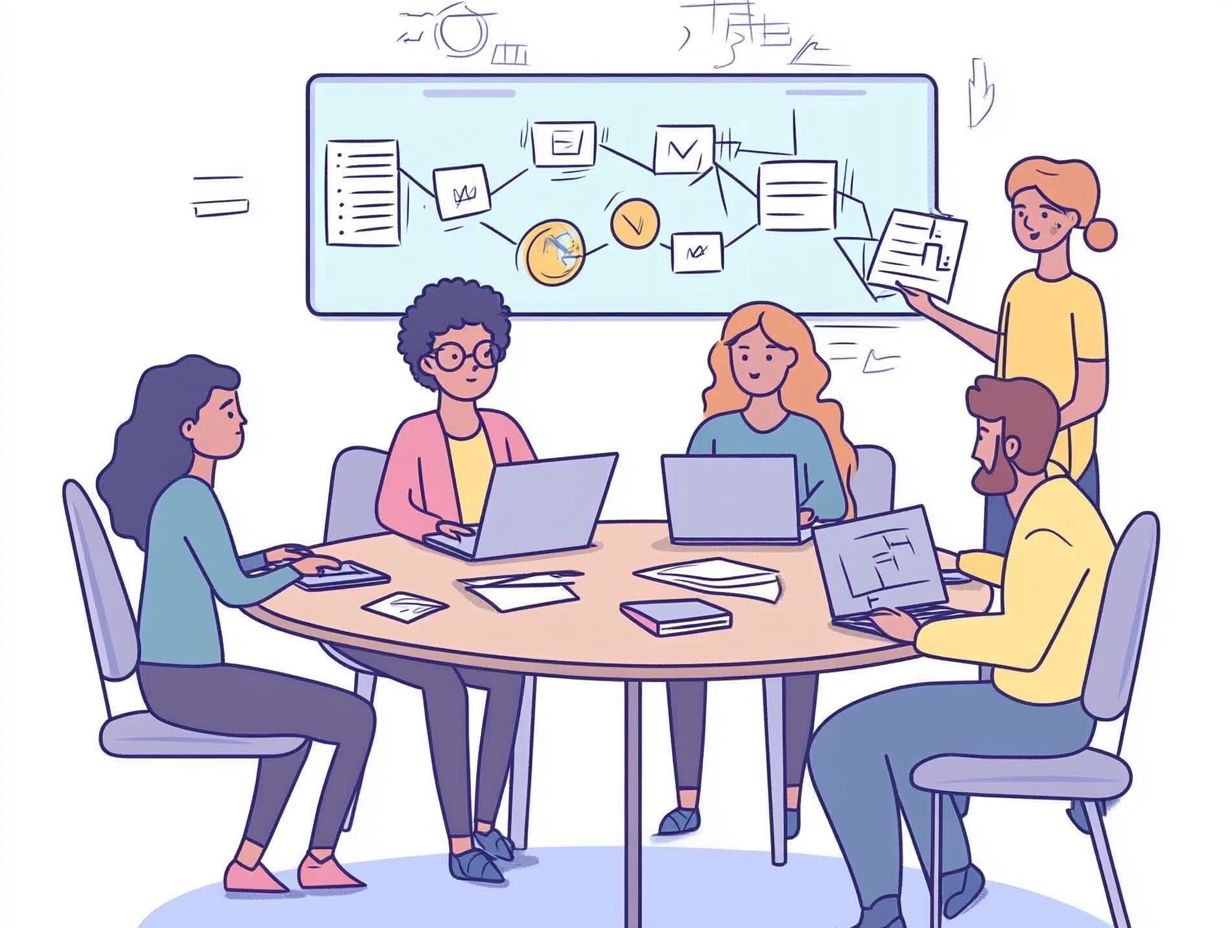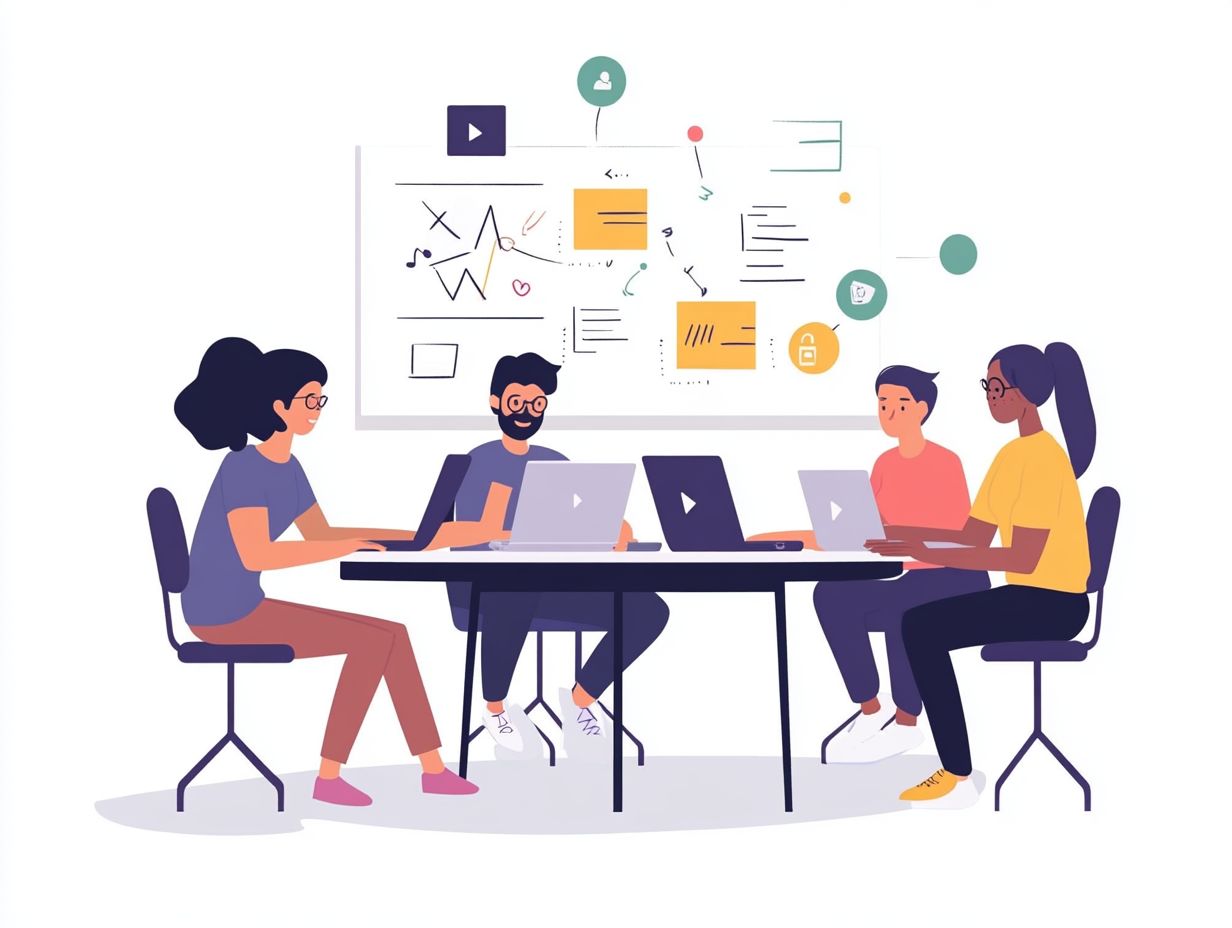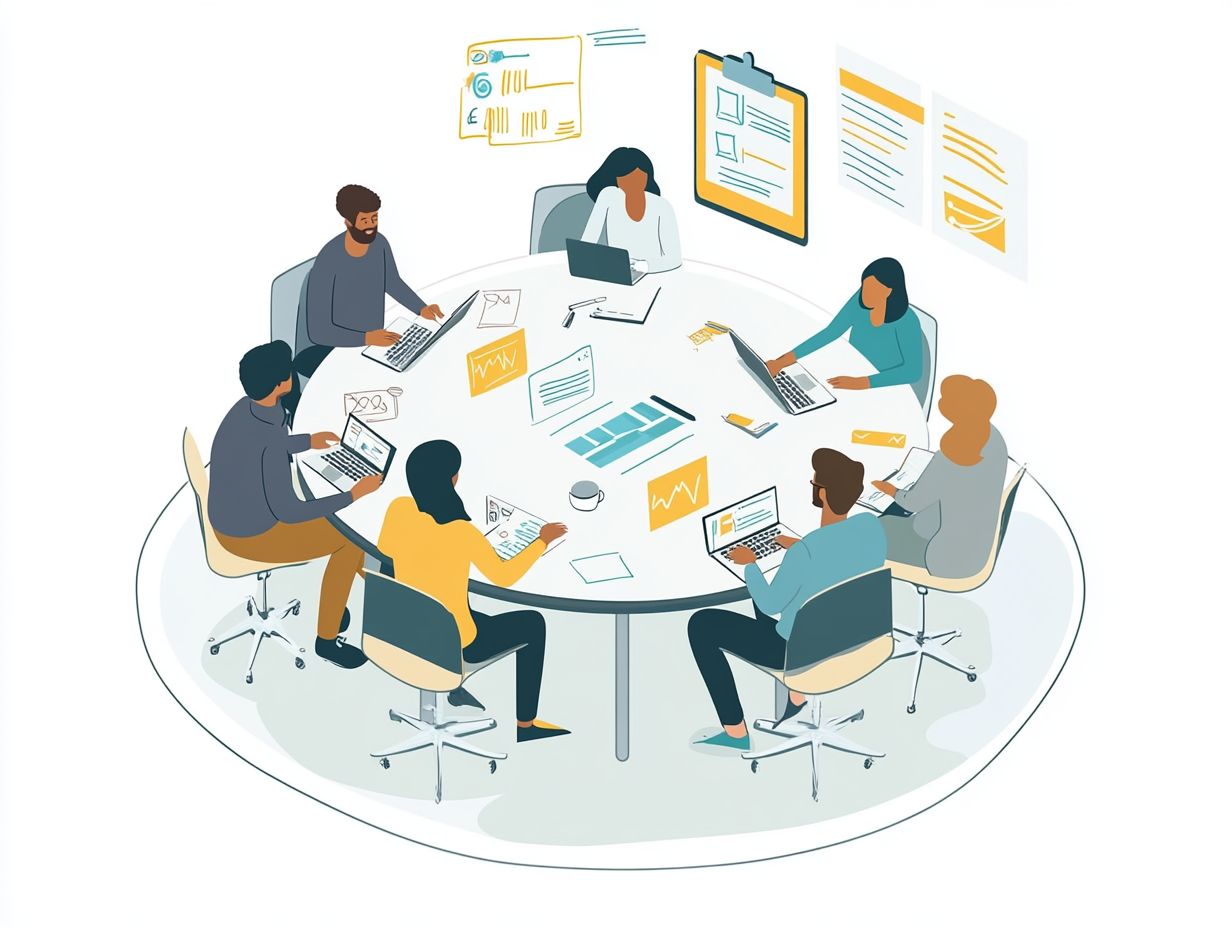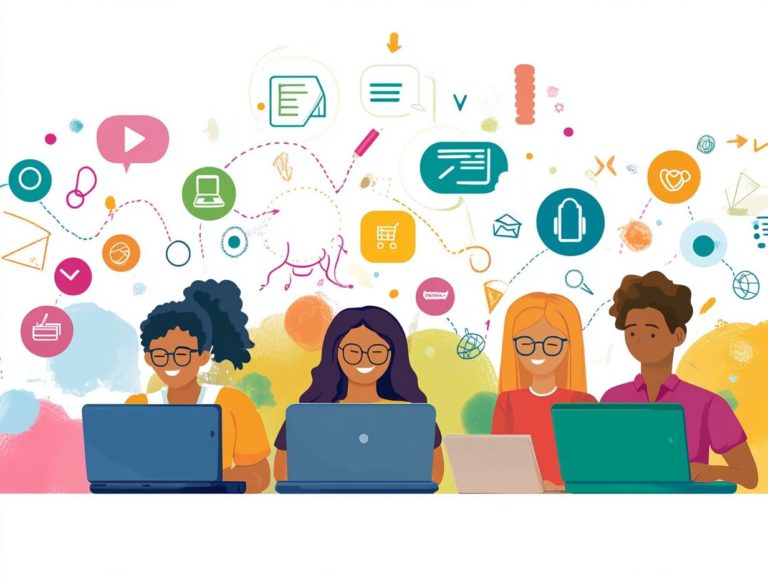Creating Engaging E-Learning Scenarios
Discover the exciting world of e-learning scenarios that can transform your learning experience! E-learning is revolutionizing your approach to education, transforming it into a more interactive and accessible experience than ever before.
One of the most effective ways to elevate this digital learning journey is through thoughtfully crafted e-learning scenarios. These scenarios captivate you by simulating real-life situations, enabling you to apply your knowledge in a practical context.
This article explores what e-learning scenarios are, their many benefits, the various types available, and the best practices for designing and implementing them. Join in to uncover how to create impactful learning experiences that enhance engagement and improve outcomes.
Contents
- Key Takeaways:
- Understanding E-Learning Scenarios
- Benefits of Using Scenarios in E-Learning
- Types of E-Learning Scenarios
- Designing Effective E-Learning Scenarios
- Implementing E-Learning Scenarios
- Measuring the Success of E-Learning Scenarios
- Frequently Asked Questions
- Wondering how to make your e-learning scenario truly engaging?
- How can I ensure my e-learning scenario is relevant and relatable to my learners?
- How important is multimedia in creating engaging e-learning scenarios?
- How can I make my e-learning scenario interactive and engaging?
- What are common mistakes to avoid when creating engaging e-learning scenarios?
- How can I measure the effectiveness of my e-learning scenario?
Key Takeaways:

- Engagement is key in e-learning scenarios. When designed effectively, scenarios can enhance engagement and improve learning outcomes.
- There are different types of e-learning scenarios, including branching scenarios and real-life simulations, each with their own benefits and considerations in design and implementation.
- To create effective e-learning scenarios, it is important to understand key elements and best practices, as well as consider technical considerations and utilize appropriate tools. Measuring success can be done through evaluating learner engagement and knowledge retention.
Understanding E-Learning Scenarios
E-learning scenarios play a pivotal role in today s educational landscape, crafted to elevate the learning experience for a wide range of audiences. By incorporating engaging and interactive content, these scenarios clarify learning objectives and tackle the challenges of feeling overwhelmed by too much information.
They empower you to delve into real-life applications of knowledge, dramatically enhancing both motivation and retention rates in various online training settings.
What are E-Learning Scenarios?
E-learning scenarios serve as detailed stories meticulously crafted to enhance your learning journey through interactive activities.
These scenarios immerse you in realistic settings that mirror real-world challenges, fostering a deeper engagement and understanding of the material. Often designed with branching paths, they empower you to make decisions that directly impact outcomes, highlighting the consequences of your choices.
The primary aim is to sharpen your critical thinking and problem-solving skills while catering to diverse learning styles. In instructional design, these scenarios can seamlessly integrate multimedia elements like videos, quizzes, and discussions, crafting a more dynamic and immersive experience.
Ultimately, they bolster knowledge retention and equip you for practical applications in your chosen field, ensuring you’re well-prepared for what lies ahead.
Benefits of Using Scenarios in E-Learning
Utilizing e-learning scenarios in educational settings offers a wealth of benefits that significantly enhance both engagement and knowledge retention for you as a learner. By fostering emotional experiences and incorporating real-life contexts, these scenarios act as compelling engagement strategies.
These scenarios capture your interest and encourage a deeper understanding of course objectives, making your learning experience all the more enriching.
Enhancing Engagement and Learning Outcomes
Enhancing engagement and learning outcomes stands as a primary goal of effective instructional design, especially through the use of e-learning scenarios.
By leveraging various strategies to boost motivation, you can cultivate an environment where learners feel empowered to take ownership of their education. Integrating timely and constructive feedback within these scenarios offers clarity on progress, fostering a sense of achievement that encourages further participation.
Applying key instructional design principles, such as customized learning paths and multimedia elements, ensures that your content remains relevant and appealing. This engaging content not only enriches the learning experience but also influences learner behaviors, increasing the likelihood that they will remain committed and achieve their desired outcomes.
Types of E-Learning Scenarios

You will encounter a range of e-learning scenarios, each carefully designed to achieve specific learning goals and audience needs.
Consider branching scenarios and real-life simulations. These approaches harness interactive elements to deliver immersive experiences that enhance knowledge acquisition and promote practical application.
Branching Scenarios
Branching scenarios offer a sophisticated form of e-learning content that give you the power to make choices and decisions that shape your learning experience.
These interactive pathways foster an active learning space where each decision leads to different outcomes. This cultivates a sense of agency and involvement.
As you navigate through various possibilities, you ll enhance your critical thinking and problem-solving skills. For example, choosing one option can unveil unique paths and consequences that mirror real-world situations, boosting your engagement along the way.
This approach captures your attention and significantly enhances learning retention. You’ll find that experiences tied to your own choices are far more memorable, making the entire process truly impactful.
Real-life Simulations
Real-life simulations offer you immersive experiences that mirror real-world situations, significantly enhancing your skills and application of knowledge.
These engaging scenarios cultivate your critical thinking and problem-solving abilities, and encourage collaboration among participants.
By immersing yourself in simulations, you can explore various roles and responsibilities within a controlled environment. This grants you the freedom to make mistakes and learn from them without real-life consequences.
This experiential learning approach aligns seamlessly with educational objectives, effectively bridging the gap between theoretical knowledge and practical execution.
Ultimately, these immersive simulations equip you with the competencies needed to navigate complex real-world challenges with confidence.
Designing Effective E-Learning Scenarios
Designing effective e-learning scenarios is exciting and requires your full attention to best practices in instructional design.
It s essential to ensure that these scenarios engage your audience and remain relevant to their needs.
This means aligning each scenario with specific learning objectives while weaving in elements that spark curiosity and evoke emotional responses.
By doing so, you elevate the overall learning experience, making it not only informative but also truly enriching.
Key Elements and Best Practices
Key elements and best practices in e-learning design are essential for creating scenarios that engage you and help you achieve your educational goals.
By incorporating interactive elements like quizzes, simulations, and branching scenarios, designers can craft a more immersive learning experience that resonates with you.
Effective feedback mechanisms are also crucial. Timely and constructive feedback helps you gauge your progress and serves as a motivating force to push you toward improvement.
Aligning e-learning scenarios with specific learning objectives enhances content relevance, ultimately increasing your investment and retention of the material.
When these components are thoughtfully woven together, they create a vibrant learning environment where you can truly thrive, transforming education into an experience that is not only informative but also enjoyable and memorable.
Implementing E-Learning Scenarios

Implementing e-learning scenarios requires careful attention to a range of technical considerations and tools to ensure seamless integration into online training programs.
You must select the right technology and create a navigation experience that flows effortlessly. Each element plays a vital role in crafting an engaging learning environment that caters to the needs of your learners.
Dive into the world of e-learning and see how these strategies can elevate your training programs!
Technical Considerations and Tools
Technical considerations and tools are essential for your successful implementation of e-learning scenarios. They directly influence usability and learner engagement.
In today s digital landscape, learners expect seamless interactions across various devices and platforms. Ensuring compatibility with multiple operating systems and browsers significantly elevates the overall user experience.
Use powerful authoring tools like Articulate Storyline or Adobe Captivate to create captivating content that incorporates multimedia and interactive elements. This approach captures learners’ attention.
Integrating Learning Management Systems (LMS) is vital for your success! These are software applications that manage training programs and track learner progress, such as Moodle or Canvas. The emphasis on usability cannot be overstated; intuitive navigation and accessible design lay the foundation for an effective learning environment.
Measuring the Success of E-Learning Scenarios
Measuring the success of e-learning scenarios is essential for understanding their impact on learner engagement and knowledge retention. This insight offers valuable information on how effectively these scenarios meet learning objectives.
Employ a range of assessment techniques to analyze the learning process and refine your strategies as needed.
Evaluating Learner Engagement and Knowledge Retention
Evaluating learner engagement and knowledge retention is crucial for assessing the effectiveness of your e-learning scenarios. This assessment provides valuable insights into how well participants grasp the material and highlights areas for improvement.
Utilize various assessment techniques such as quizzes, interactive activities, and peer evaluations to collect meaningful data on learner performance. Implementing robust feedback mechanisms creates a two-way communication channel. This allows learners to share their thoughts and experiences, directly connecting evaluation to improved learning outcomes. Tailor your approach based on real-time insights into student needs and preferences.
Frequently Asked Questions
Wondering how to make your e-learning scenario truly engaging?

Key elements to consider include:
- Learning objectives
- Target audience
- Use of multimedia
- Level of interactivity
- Overall design and structure
How can I ensure my e-learning scenario is relevant and relatable to my learners?
Incorporate real-life examples and scenarios that align with the learners’ experiences and job roles to ensure relevance and relatability.
How important is multimedia in creating engaging e-learning scenarios?
The use of multimedia such as images, videos, and interactive elements greatly enhances learner engagement and retention. It is a crucial element in effective e-learning scenarios.
How can I make my e-learning scenario interactive and engaging?
Include decision-making points, quizzes, simulations, and other activities that require active participation from learners to make your scenario interactive.
What are common mistakes to avoid when creating engaging e-learning scenarios?
Avoid these common mistakes:
- Overloading the scenario with too much information
- Making it too lengthy
- Not considering learners’ needs and preferences
How can I measure the effectiveness of my e-learning scenario?
Measure effectiveness through assessments, surveys, and feedback from learners. Regular updates based on this data can continually enhance engagement and effectiveness.
Start creating engaging e-learning scenarios today and watch your learners thrive!






